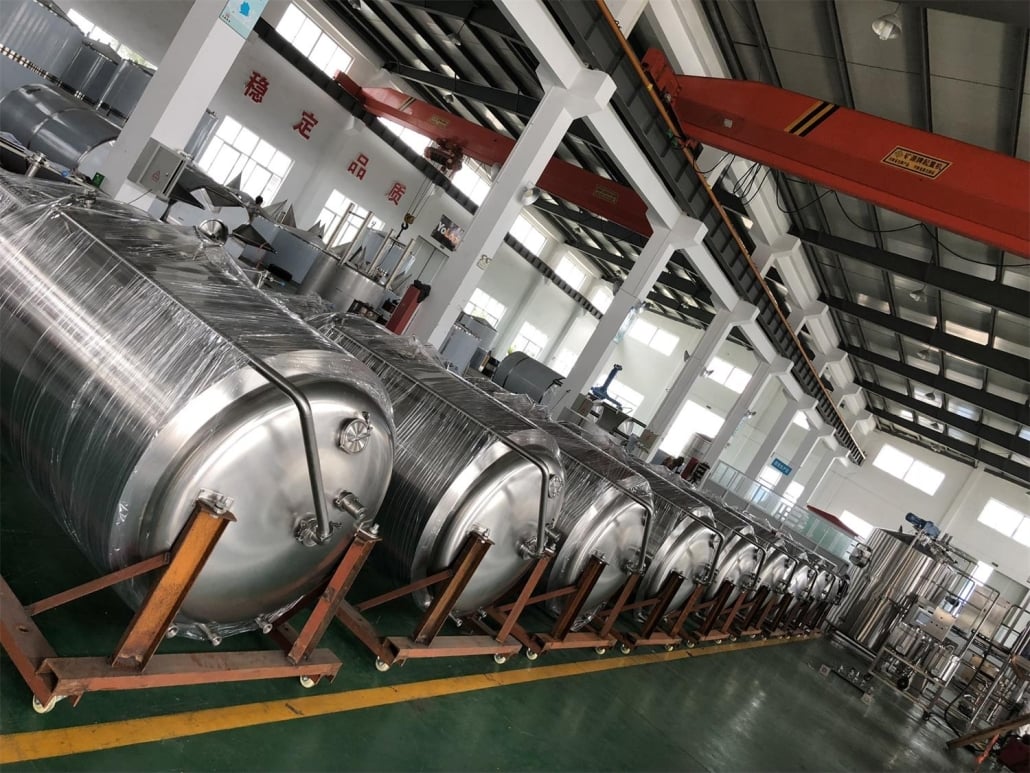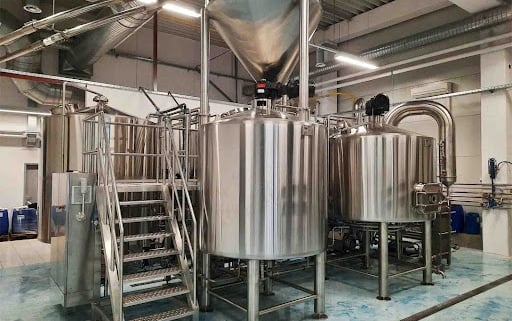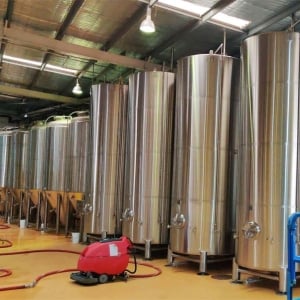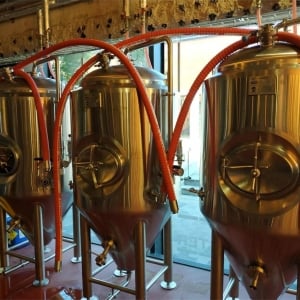Commercial Beer Brewing Systems
Dreaming of brewing your own beer on a grand scale? If you’re ready to take your passion for craft beer to the professional level, then investing in a commercial beer brewing system is the key to brewing up your next big batch. But where do you begin?
This comprehensive guide will walk you through everything you need to know about commercial beer brewing systems, from the essential equipment you’ll need to consider to navigating the brewing process itself. We’ll even delve into the nitty-gritty details like choosing a supplier, installation, and ongoing maintenance to keep your brewery running smoothly. So, grab a (virtual) pint, and let’s dive into the world of commercial beer brewing systems!
Essential Equipment Guide for Commercial Beer Brewing Systems
Every commercial brewery, regardless of size, needs a core set of workhorses to transform humble grains and hops into the delicious craft beers we love. Here’s a breakdown of the key players in your brewing system:
| Equipment | Description |
|---|---|
| Mash Tun | This stainless steel vat is where the magic begins. Here, crushed grains are steeped in hot water, converting starches into fermentable sugars. |
| Lauter Tun | The wort (sugar-rich liquid) is separated from the spent grains in the Lauter Tun through a filtration process. |
| Kettle | The wort is brought to a boil in the kettle, where hops are added for bitterness, flavor, and aroma. |
| Whirlpool Tank | This tank creates a whirlpool motion, separating the wort from hop trub (hop residue) for a clearer beer. |
| Heat Exchanger | This essential piece of equipment rapidly cools the wort down to a temperature suitable for yeast fermentation. |
| Fermentation Tanks | Stainless steel tanks where the cooled wort is pitched with yeast, and the fermentation process transforms the sugars into alcohol and CO2. |
| Brite Tanks | After fermentation, beer is conditioned and clarified in these tanks before packaging. |
| Cleaning System | Maintaining a sanitary brewing environment is crucial. A Cleaning System (CIP – Cleaning In Place) ensures a thorough cleaning regimen. |

Understanding the Brewing Process
Now that you’re familiar with the key equipment, let’s take a step-by-step look at the brewing process itself:
- Mashing: Crushed malt (grain) is mixed with hot water in the Mash Tun, where enzymes convert starches into fermentable sugars. Imagine it as a giant bowl of porridge, where the starches are being broken down into simple sugars that the yeast can later feast on.
- Lautering: The sweet liquid extract, called wort, is separated from the spent grains in the Lauter Tun through a specialized lauter bed. Think of it as straining the porridge to remove the chunky bits, leaving behind the sweet, sugary goodness.
- Boiling: The wort is transferred to the kettle and brought to a boil. This is where hops are added, giving the beer its bitterness, aroma, and acting as a natural preservative. The boiling process also helps to sterilize the wort and concentrate the sugars.
- Whirlpooling: The hot wort is spun rapidly in a whirlpool tank, separating the wort from the hop trub (hop residue) for a clearer beer. Imagine swirling a glass of water with some grass clippings in it – the centrifugal force pushes the heavier grass to the center, allowing you to skim it off for a clearer drink.
- Cooling: The wort is then rapidly cooled down to a temperature suitable for yeast fermentation using a heat exchanger. This sudden temperature drop also helps to prevent unwanted bacteria growth.
- Fermentation: The cooled wort is transferred to fermentation tanks and pitched with yeast. These tiny organisms go to work, consuming the sugars and producing alcohol and CO2 as byproducts. This is where the magic happens, transforming the sweet wort into your favorite beer!
- Conditioning and Packaging: After fermentation is complete, the beer is transferred to brite tanks for conditioning and clarification. From here, the beer is ready to be packaged into kegs, bottles, or cans for thirsty customers!
Choosing the Right Capacity and Design for Your Brewery
The size and layout of your commercial brewing system will depend on several factors, including your production goals, available space, and budget. Here’s a table to help you visualize some key considerations:
| Factor | Description |
|---|---|
| Production Capacity | How much beer do you plan to brew per batch and annually? |
| Available Space | Consider the footprint of your equipment and ensure there’s room for future expansion. |
| Budget | Commercial brewing systems are a significant investment. Determine your budget upfront |
Commercial Beer Brewing Systems
Dreaming of brewing your own beer on a grand scale? If you’re ready to take your passion for craft beer to the professional level, then investing in a commercial beer brewing system is the key to brewing up your next big batch. But where do you begin?
This comprehensive guide will walk you through everything you need to know about commercial beer brewing systems, from the essential equipment you’ll need to consider to navigating the brewing process itself. We’ll even delve into the nitty-gritty details like choosing a supplier, installation, and ongoing maintenance to keep your brewery running smoothly. So, grab a (virtual) pint, and let’s dive into the world of commercial beer brewing systems!
Essential Equipment Guide for Commercial Beer Brewing Systems
Every commercial brewery, regardless of size, needs a core set of workhorses to transform humble grains and hops into the delicious craft beers we love. Here’s a breakdown of the key players in your brewing system:
| Equipment | Description |
|---|---|
| Mash Tun | This stainless steel vat is where the magic begins. Here, crushed grains are steeped in hot water, converting starches into fermentable sugars. |
| Lauter Tun | The wort (sugar-rich liquid) is separated from the spent grains in the Lauter Tun through a filtration process. |
| Kettle | The wort is brought to a boil in the kettle, where hops are added for bitterness, flavor, and aroma. |
| Whirlpool Tank | This tank creates a whirlpool motion, separating the wort from hop trub (hop residue) for a clearer beer. |
| Heat Exchanger | This essential piece of equipment rapidly cools the wort down to a temperature suitable for yeast fermentation. |
| Fermentation Tanks | Stainless steel tanks where the cooled wort is pitched with yeast, and the fermentation process transforms the sugars into alcohol and CO2. |
| Brite Tanks | After fermentation, beer is conditioned and clarified in these tanks before packaging. |
| Cleaning System | Maintaining a sanitary brewing environment is crucial. A Cleaning System (CIP – Cleaning In Place) ensures a thorough cleaning regimen. |
Understanding the Brewing Process
Now that you’re familiar with the key equipment, let’s take a step-by-step look at the brewing process itself:
- Mashing: Crushed malt (grain) is mixed with hot water in the Mash Tun, where enzymes convert starches into fermentable sugars. Imagine it as a giant bowl of porridge, where the starches are being broken down into simple sugars that the yeast can later feast on.
- Lautering: The sweet liquid extract, called wort, is separated from the spent grains in the Lauter Tun through a specialized lauter bed. Think of it as straining the porridge to remove the chunky bits, leaving behind the sweet, sugary goodness.
- Boiling: The wort is transferred to the kettle and brought to a boil. This is where hops are added, giving the beer its bitterness, aroma, and acting as a natural preservative. The boiling process also helps to sterilize the wort and concentrate the sugars.
- Whirlpooling: The hot wort is spun rapidly in a whirlpool tank, separating the wort from the hop trub (hop residue) for a clearer beer. Imagine swirling a glass of water with some grass clippings in it – the centrifugal force pushes the heavier grass to the center, allowing you to skim it off for a clearer drink.
- Cooling: The wort is then rapidly cooled down to a temperature suitable for yeast fermentation using a heat exchanger. This sudden temperature drop also helps to prevent unwanted bacteria growth.
- Fermentation: The cooled wort is transferred to fermentation tanks and pitched with yeast. These tiny organisms go to work, consuming the sugars and producing alcohol and CO2 as byproducts. This is where the magic happens, transforming the sweet wort into your favorite beer!
- Conditioning and Packaging: After fermentation is complete, the beer is transferred to brite tanks for conditioning and clarification. From here, the beer is ready to be packaged into kegs, bottles, or cans for thirsty customers!
Choosing the Right Capacity and Design for Your Brewery
The size and layout of your commercial brewing system will depend on several factors, including your production goals, available space, and budget. Here’s a table to help you visualize some key considerations:
| Factor | Description |
|---|---|
| Production Capacity | How much beer do you plan to brew per batch and annually? |
| Available Space | Consider the footprint of your equipment and ensure there’s room for future expansion. |
| Budget | Commercial brewing systems are a significant investment. Determine your budget upfront |
| Advantage | Disadvantage |
|---|---|
| Profit Potential: Craft beer enjoys strong consumer demand, offering the potential for a profitable business. | Competition: The craft beer market is becoming increasingly saturated, so standing out is crucial. |
| Creative Freedom: Experiment with recipes, ingredients, and brewing techniques to develop your signature beers. | Licensing and Regulations: Navigating brewing regulations and obtaining the necessary licenses can be complex. |
| Job Creation: Breweries create jobs for brewers, servers, distributors, and marketing personnel. | Long Hours and Hard Work: Running a brewery requires dedication, long hours, and a commitment to quality. |

FAQs
Q: I have a limited budget. Can I still start a commercial brewery?
A: Yes, there are options for starting small. Nano brewey systems with a production capacity of 1-3 barrels are a good entry point. You can also explore used equipment options to reduce upfront costs. However, be mindful of long-term maintenance needs for used equipment.
Q: What brewing licenses and permits do I need?
A: Licensing requirements vary depending on your location. Generally, you’ll need a federal Brewers Notice from the Alcohol and Tobacco Tax and Trade Bureau (TTB) and a state license to operate a brewery. It’s advisable to consult with a lawyer or accountant specializing in the beverage industry to ensure you have all the necessary permits.
Q: How can I market my craft beer?
A: Developing a strong brand identity and crafting unique beers are essential for standing out in a crowded market. Utilize social media marketing, participate in local events, and build relationships with bars, restaurants, and distributors to get your beer into the hands of thirsty customers.
Q: What are some resources to help me learn more about commercial brewing?
A: The Brewers Association is a fantastic resource for aspiring brewers, offering educational resources, industry publications, and online courses. Local chapters of the association can also provide valuable networking opportunities. There are also numerous brewing publications, websites, and online forums dedicated to craft beer and the brewing industry.













